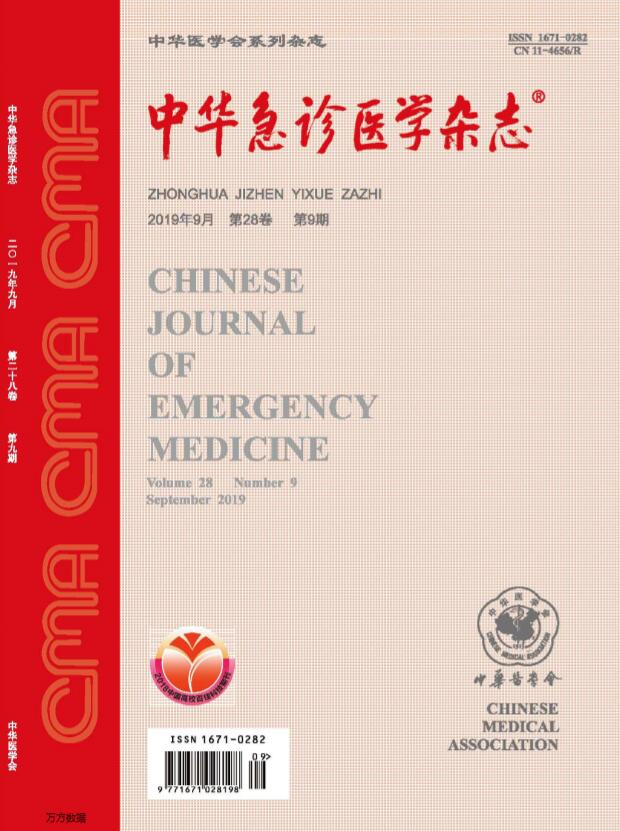急性A型主动脉夹层风险预测模型的建立
Q4 Nursing
引用次数: 1
摘要
目的分析急性A型主动脉夹层的相关危险因素,建立有效的预测评分模型,为临床早期干预提供依据。方法回顾性分析2012年4月1日至2017年3月31日在广东省人民医院急诊科诊断为急性A型主动脉夹层的200例患者作为建模组。男性160例,女性40例,年龄(53.30±13.19)岁。根据CTA检查后72h内夹层破裂的标准,将患者分为破裂组(100例)和未破裂组(100例)。通过对急性A型主动脉夹层早期危险因素的多因素Logistic回归分析,建立破裂风险预测模型。模型建立后,对我院2017年4月1日至2018年5月31日诊断为急性a型主动脉夹层的80例患者进行前瞻性回顾,作为验证组。男性57例,女性23例,年龄(54.00±13.68)岁。验证组有破裂53例,无破裂27例。并在验证组中对该模型进行验证。根据建模组受试者工作模型曲线的最佳截断值将评分分为低风险破裂和高风险破裂。结果通过Logistic回归分析,最终建立了10个因素的破裂风险预测评分模型。影响因素为:年龄>63岁(2分)、女性(2分)、呼吸机辅助通气(3分)、AST >80 U/L(2分)、内膜未变形(2分)、主动脉窦直径> 41mm(1分)、升主动脉最大直径> 48mm(1分)、假腔面积与真腔面积之比>2.12(2分)、Lac >1.9 mmol/L(3分)、WBC >14.2×109 /L(1分)。验证结果表明,评分模型具有较高的预测值(AUC = 0.928, 95% CI: 0.872 ~ 0.984, P < 0.001)和拟合优度(Hosmer-Lemeshow χ2 = 8.331, P = 0.402)。评分模型进一步分为低危(0 ~ 6分)和高危(7 ~ 19分),敏感性为83.0%,特异性为86.0%。结论CTA术后72h内建立的急性A型主动脉夹层夹层风险预测模型有助于病情的评估和早期干预,具有一定的临床应用价值。关键词:主动脉夹层;破裂;风险因素;风险评分;模型本文章由计算机程序翻译,如有差异,请以英文原文为准。
Construction of risk prediction model for acute type A aortic dissection
Objective
To analyze the risk factors associated with acute type A aortic dissection, and to establish an effective predictive scoring model for early clinical intervention.
Methods
A retrospective review of 200 patients diagnosed as acute type A aortic dissection in the Department of Emergency, Guangdong Provincial People's Hospital between April 1, 2012 and March 31, 2017 was conducted as a modeling group. There were 160 males and 40 females with age of (53.30 ±13.19) years. According to the criteria of dissection rupture within 72 h after CTA examination, patients were divided into a rupture group (100 cases) and an unruptured group (100 cases). A prediction model of rupture risk was established based on the multivariate Logistic regression analysis of the risk factors of acute A-type aortic dissection in the early stage. After the establishment of the model, a prospective review of 80 patients diagnosed as acute type A aortic dissection in our hospital between April 1, 2017 and May 31, 2018 was conducted as a validation group. There were 57 males and 23 females with age of (54.00 ±13.68) years. In the validation group, there were 53 patients with rupture and 27 patients without rupture. Furthermore, this model was verified in the validation group. The scores were divided into low-risk rupture and high-risk rupture according to the best cut-off value of the receiver operating model curve of the modeling group.
Results
Logistic regression analysis showed that 10 factors were finally established the rupture risk prediction score model. The factors were as following: age >63 years (2 points), women (2 points), ventilator assisted ventilation (3 points), AST >80 U/L (2 points), no distortion of the inner membrane (2 points), diameter of the aortic sinus >41 mm (1 point), maximum diameter of the ascending aorta >48 mm (1 point), ratio of false lumen area to true lumen area >2.12 (2 points), Lac >1.9 mmol/L (3 points), and WBC >14.2×109 /L (1 point). The results of validation showed that the scoring model had a high predictive value (AUC = 0.928, 95% CI: 0.872-0.984, P < 0.001) and goodness of fit (Hosmer-Lemeshow χ2 = 8.331, P = 0.402). Moreover, the scoring model was further divided into low-risk (0-6 points) and high-risk (7-19 points), with sensitivity of 83.0% and specificity of 86.0%.
Conclusions
The predictive model of dissection risk in the acute type A aortic dissection constructed within 72 h after CTA is helpful for the evaluation of the disease and early intervention, and has certain clinical application value.
Key words:
aortic dissection; rupture; risk factors; risk score; model
求助全文
通过发布文献求助,成功后即可免费获取论文全文。
去求助
来源期刊

中华急诊医学杂志
Nursing-Emergency Nursing
CiteScore
0.10
自引率
0.00%
发文量
8629
期刊介绍:
Chinese Journal of Emergency Medicine is the only national journal which represents the development of emergency medicine in China. The journal is supervised by China Association of Science and Technology, sponsored by Chinese Medical Association, and co-sponsored by Zhejiang University. The journal publishes original research articles dealing with all aspects of clinical practice and research in emergency medicine. The columns include Pre-Hospital Rescue, Emergency Care, Trauma, Resuscitation, Poisoning, Disaster Medicine, Continuing Education, etc. It has a wide coverage in China, and builds up communication with Hong Kong, Macao, Taiwan and international emergency medicine circles.
 求助内容:
求助内容: 应助结果提醒方式:
应助结果提醒方式:


